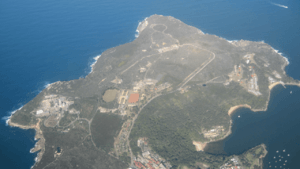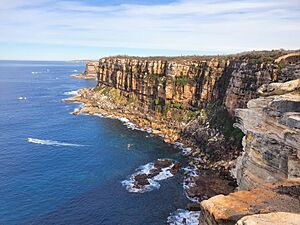North Head, New South Wales facts for kids
Quick facts for kids North Head |
|
|---|---|
| Car-rang-gel | |

Aerial View of North Head
|
|
| Location | Port Jackson |
| Coordinates | 33°48′54″S 151°18′04″E / 33.815°S 151.301°E |
| Geology | Headland |
North Head is a famous headland located in Sydney, New South Wales, Australia. It's like a big, rocky wall that stands proudly at the entrance to Port Jackson, which is Sydney Harbour. For hundreds of years, especially since the first European ships arrived in 1788, North Head has been a welcoming sight for sailors coming to Australia. It's also a very important place, listed on the Australian National Heritage List because of its history and natural beauty.
Contents
What is North Head?
North Head is a tall, rocky piece of land that sticks out into the ocean. It forms the northern side of the entrance to Sydney Harbour. On the southern side is another headland called South Head. Together, they create a grand gateway to one of the world's most beautiful harbours.
- A Natural Landmark: North Head is known for its dramatic cliffs and amazing views of the Pacific Ocean and Sydney city.
- Part of a National Park: Much of North Head is protected as part of the Sydney Harbour National Park. This means its natural environment and historical sites are preserved for everyone to enjoy.
Why is it called a Headland?
A headland is a piece of land that extends out into a body of water, often with steep cliffs. Think of it like a "head" sticking out from the "body" of the coastline. These natural features are often formed by erosion, where softer rocks wear away, leaving harder rocks behind.
A Place of History: The Quarantine Station
One of the most interesting parts of North Head is the North Head Quarantine Station. This historic site played a very important role in Australia's past.
What was the Quarantine Station for?
From 1832 to 1984, the Quarantine Station was a place where people arriving in Australia by ship had to stay if they were suspected of carrying infectious diseases.
- Stopping the Spread: In the past, diseases like smallpox, cholera, and the bubonic plague were very dangerous. If a ship had sick passengers, they couldn't enter Sydney until it was safe.
- A Place of Isolation: Passengers and crew would stay at the station for weeks or even months. They lived in special buildings, and their clothes and belongings were disinfected. This helped protect the people already living in Australia from getting sick.
- Different Classes: The station had different areas for first-class, second-class, and steerage passengers. This meant people from different social backgrounds were kept separate, even during quarantine.
Life at the Station
Life at the Quarantine Station could be challenging, but it was also a unique experience for many.
- Daily Routines: People had to follow strict rules. They had medical checks, and their days were structured around preventing the spread of illness.
- Learning and Leisure: Despite the isolation, there were often schools for children and activities to keep people busy. Some even carved messages into the sandstone rocks, which you can still see today!
- A Final Resting Place: Sadly, some people did not survive their illnesses and were buried at the station's cemetery.
North Head and the First Fleet
North Head holds a special place in Australia's history because of its connection to the arrival of the First Fleet in 1788.
- The First Sight: When the eleven ships of the First Fleet, carrying convicts and settlers from Britain, sailed into Botany Bay in January 1788, they soon realised it wasn't a suitable place for a new settlement.
- Finding Port Jackson: Captain Arthur Phillip then explored further north and discovered the magnificent natural harbour of Port Jackson. North Head was one of the first major landmarks they saw as they sailed into what would become Sydney Harbour.
- A New Beginning: The fleet then moved to Port Jackson, and on 26 January 1788, the British flag was raised at Sydney Cove, marking the beginning of European settlement in Australia. North Head stood as the silent witness to this historic moment.
Nature and Wildlife at North Head
Beyond its history, North Head is also a haven for nature lovers. It's home to unique plants and animals, and offers stunning natural beauty.
- Coastal Heathland: The headland is covered in a type of vegetation called coastal heathland. This includes many native plants that are tough enough to survive the salty winds and sandy soil.
- Birdwatching: Many different bird species live here, including New Holland Honeyeaters and Superb Fairy-wrens. You might even spot a White-bellied Sea-eagle soaring above the cliffs.
- Marine Life: The waters around North Head are part of a marine park. You can sometimes see whales migrating along the coast, especially between May and November. Dolphins are also common visitors to the harbour entrance.
Exploring North Head Today
Today, North Head is a popular spot for both locals and tourists. It offers a mix of history, nature, and incredible views.
- Walking Trails: There are several walking tracks that allow you to explore the headland, from easy strolls to more challenging hikes. These trails offer breathtaking views of the ocean, the harbour, and the Sydney skyline.
- Lookouts: Various lookouts provide perfect spots for photography and enjoying the scenery. Fairfax Walk, for example, leads to lookouts with panoramic views.
- Learning About the Past: The former Quarantine Station is now a heritage-listed hotel and conference centre, but you can still visit parts of it and learn about its fascinating history through guided tours.
- Picnic Spots: Many areas are perfect for a picnic with family and friends, surrounded by nature and history.
North Head is truly a special place where history, nature, and stunning views come together, offering a unique experience for everyone who visits.


